What is Additive Manufacturing? A Comprehensive Guide to 3D Printing Technology
This article examines what additive manufacturing encompasses, clarifies its relationship to 3D printing technologies, and explores the specific methodologies and materials involved in this innovative manufacturing approach.
This article was first published on
ultimaker.comAdditive manufacturing has emerged as a transformative technology in modern production processes.
This article examines what additive manufacturing encompasses, clarifies its relationship to 3D printing technologies, and explores the specific methodologies and materials involved in this innovative manufacturing approach.
Understanding additive manufacturing: Definition and meaning
Additive manufacturing (AM), also known as 3D printing, is a revolutionary manufacturing process that builds three-dimensional objects by depositing materials layer by layer. Unlike traditional subtractive manufacturing methods that cut away material, AM adds material to create parts directly from digital 3D models.
At its core, additive manufacturing is defined by the American Society for Testing and Materials (ASTM) as "the process of joining materials to make parts from 3D model data, usually layer upon layer." This process stands in stark contrast to conventional manufacturing techniques like machining, molding, or casting.
Key principles of additive manufacturing
The fundamental principles of additive manufacturing include:
- Layer-by-layer construction: Objects are built up gradually by depositing thin layers of material.
- Digital design input: Parts are created directly from 3D CAD models or scanned data.
- Material addition vs. subtraction: Material is added selectively rather than removed from a larger block.
- Design freedom: Complex geometries can be produced that would be difficult or impossible with traditional methods.
Additive manufacturing enables the production of parts with intricate internal structures, customized designs, and optimized geometries that can reduce weight while maintaining strength. This design freedom opens up new possibilities for innovation across industries.
The additive manufacturing process
While specific techniques vary, the general AM process follows these steps:
- Create a 3D digital model using CAD software
- Convert the model to a standard file format (usually STL)
- Slice the model into thin layers using Cura.
- Set up the 3D printer with appropriate materials
- Build the object layer by layer
- Post-process as needed (remove supports, surface finishing, etc.)
This digital-to-physical workflow allows for rapid iteration, customization, and on-demand production - key advantages that set additive manufacturing apart from conventional techniques.
The evolution of additive manufacturing: From 3D printing to industrial applications
Additive manufacturing has undergone significant evolution since its inception, transforming from a rapid prototyping tool to a versatile manufacturing process with wide-ranging industrial applications. This journey reflects the technology's growing capabilities and its increasing impact across various sectors.
The early days: rapid prototyping
Additive manufacturing's roots can be traced back to the 1980s.
Several researchers, including Dr. Hideo Kodama of Nagoya Municipal Industrial Research Institute, Japan, Alain le Méhauté, a French researcher, and Jean-Claude André who was working at the French National Center for Scientific Research (CNRS), hypothesized and began experimenting the possibility of building objects out of thin air in so-called rapid-prototyping.
However, all of the above researchers could not crack the invention till 1984 when an American engineer named Charles Hull published his paper on a rapid prototyping system. He was granted the patent in 1986. He named the technology as Stereolithography Apparatus (SLA). Within a few years, another pioneer by the name of Scott Crump invented a slightly different technology - fused deposition modeling (FDM) - and suddenly there were multiple additive manufacturing technologies.
Expansion of technologies and materials
- Fused Deposition Modeling (FDM): Developed in 1988, FDM became popular for its simplicity and affordability.
- Selective Laser Sintering (SLS): Introduced in the early 1990s, SLS expanded material options to include polymers and metals.
- Direct Metal Laser Sintering (DMLS): This technology, developed in the mid-1990s, opened up new possibilities for metal part production.
The diversification of AM technologies was accompanied by an expansion in printable materials, ranging from various plastics to metals, ceramics, and even biocompatible materials for medical applications.
Transition to industrial manufacturing
While AM initially focused on prototyping, the early 2000s saw a shift towards using these technologies for end-use part production. This transition was driven by several factors:
- Improved machine reliability and precision
- Enhanced material properties and performance
- Development of design optimization tools for AM
- Growing awareness of AM's unique capabilities among industries
As a result, additive manufacturing began to find applications in aerospace, automotive, healthcare, and other industries where complex, customized, or low-volume parts were needed.
Popular brands like Ultimaker have developed high-quality professional FDM 3D printers like the S Series, a next-generation desktop 3D printing platform that delivers manufacturing-grade parts in an accessible and connected package.
Today additive manufacturing is a multi-billion dollar industry serving everything from the most advanced aerospace companies down to the savvy at-home garage-engineer and everything in between.
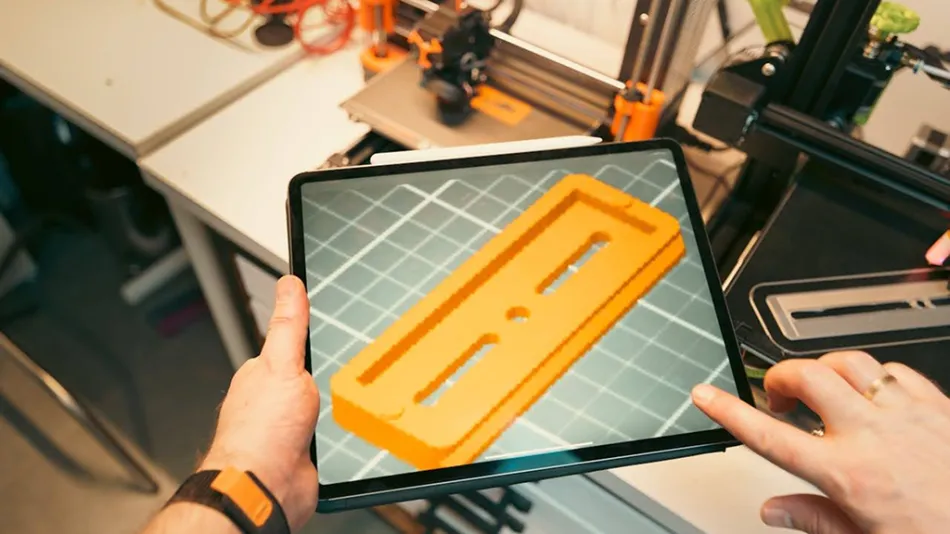
Industry 4.0 and the digital factory
The integration of AM into industrial settings has accelerated with the advent of Industry 4.0 concepts. Additive manufacturing aligns perfectly with the principles of digital manufacturing, enabling:
- On-demand production
- Decentralized manufacturing
- Mass customization
- Digital inventory and spare parts
These capabilities are reshaping supply chains and production strategies across industries, offering new levels of flexibility and efficiency.
Recent advancements and future outlook
Recent years have seen continued innovation in AM technologies, including:
- Multi-material printing: Allowing for parts with varying material properties
- Large-scale AM: Enabling the production of much larger components
- High-speed printing: Dramatically increasing production rates
- Artificial intelligence integration: Optimizing print processes and part designs
Looking ahead, additive manufacturing is poised to play an increasingly central role in industrial production. As the technology continues to mature, we can expect to see broader adoption across industries, further integration with other digital technologies, and new applications that leverage AM's unique capabilities.
Types of additive manufacturing processes
Additive manufacturing encompasses a diverse range of processes, each offering unique capabilities suited for different applications, materials, and industries. Understanding these various processes is crucial for selecting the right technology for specific manufacturing needs. Let's explore the main types of AM processes available today:
Vat photopolymerization
This category includes the original stereolithography (SLA) process, as well as newer technologies like Digital Light Processing (DLP) and Continuous Liquid Interface Production (CLIP) and Digital Light Synthesis (DLS). These processes use light to selectively cure liquid photopolymer resins:
- SLA: Uses a laser to trace and cure each layer
- DLP: Projects entire layers at once, offering faster build speeds
- CLIP: Enables continuous printing, dramatically reducing production times
All these technologies use a liquid material, namely a thermoset polymer. The liquid resin is held in a vat onto which a laser or light source is flashed. This laser or light cures (hardens) the material to make it solid one layer at a time. This process is repeated again and again till the complete object is formed. Unlike FDM, the print is done upside down with the build surface essentially pulling the print up out of the liquid resin bath.
Vat photopolymerization is known for its high resolution and smooth surface finish, making it ideal for detailed prototypes and jewelry molds.
Material extrusion - FDM
Material extrusion is also known as fused deposition modeling (FDM). An FDM 3D printer operates on a Cartesian coordinate system where the printhead (entire extruder and nozzle assembly) moves in the X & Y direction and the build platform moves in the Z-direction.
The filament is first loaded into the extruder assembly. The gear mechanism pulls the filament into the assembly and pushes it down to the heater. Here, the filament is heated up to the recommended temperature defined by the type of material used.
Once the material is heated, the material moves down to the nozzle. The nozzle then extrudes the material onto the build platform while tracing the geometry of the object to be manufactured. The nozzle traces the cross-section of the object for each layer. This is repeated till the entire object is printed.
FDM is widely used in both consumer and industrial 3D printers due to its simplicity and affordability. It's particularly useful for functional prototypes and low-cost production parts.
Powder bed fusion
This category encompasses several important industrial AM processes:
- Selective Laser Sintering (SLS): Uses a laser to sinter polymer powders
- Direct Metal Laser Sintering (DMLS): Similar to SLS but for metal powders
- Electron Beam Melting (EBM): Uses an electron beam to melt metal powders in a vacuum
All these technologies use polymer or metal materials in a powdered form. A powerful laser is flashed on the individual powder particles to sinter or melt them ultimately to form a strong bond with the adjacent particle. Thus by flashing the laser on the required particles according to the geometry, the object is formed.
Powder bed fusion technologies are capable of producing high-strength, functional parts in a wide range of materials, making them crucial for aerospace, automotive, and medical applications.
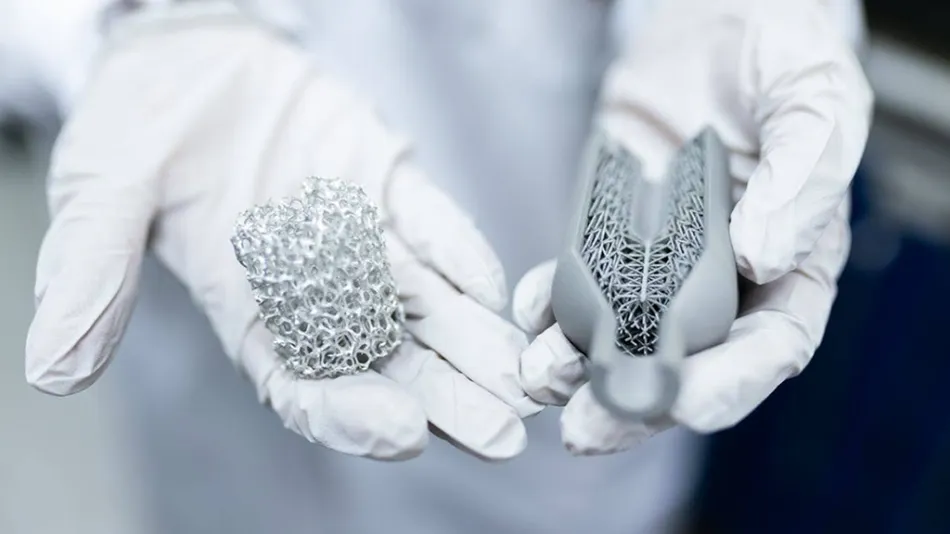
Material jetting
Similar to inkjet printing, material jetting deposits droplets of material that are then cured or solidified. This process allows for:
- Multi-material printing
- Full-color parts
- Highly accurate and smooth surfaces
Material jetting is often used for realistic prototypes, dental models, and medical training models.
Binder jetting
Binder Jetting is similar to material jetting but it uses two materials in place of one. A powder material sits in a tray and the binder material is sprayed onto it in a pattern to hold the powder together. A wiper brushes another layer of powder on top and the process is repeated.
Binder jetting can work with a variety of materials, including metals, ceramics, and polymers. It's particularly useful for:
- Large-scale parts
- Architectural models
- Sand casting molds
Directed energy deposition
This advanced process uses focused thermal energy (usually a laser) to melt materials as they are being deposited. It's primarily used for:
- Repairing or adding material to existing parts
- Producing large metal parts
- Functionally graded materials
As DED uses a laser, this process is also called Laser Engineered Net Shaping, 3D Laser Cladding, Directed Light Fabrication or Direct Metal Deposition.
Sheet lamination
Sheet lamination is an umbrella term for two techniques, namely:
Laminated object manufacturing (LOM)
LOM is used for 3D printing products using sheets of paper which are joined together using adhesive. This process uses a cross-hatch method so the completed part is easy to remove. Objects 3D-printed through LOM are only used for aesthetic purposes and are not fit for structural use.
Ultrasonic additive manufacturing (UAM)
UAM is similar to LOM but differs in the material used. Here, metal sheets are used in place of paper sheets and they are joined together by welding in place the adhesive for LOM. This technology can 3D print with metals such as aluminum, copper, steel, and titanium. As the metals don’t need to be heated, this process requires relatively less energy.
While less common than other AM processes, it's useful for creating low-cost, full-color prototypes and for some composite applications.
Emerging technologies
The field of additive manufacturing continues to evolve, with new processes emerging to address specific challenges or unlock new capabilities:
- Volumetric Additive Manufacturing: Creates entire 3D objects at once, rather than layer-by-layer
- 4D Printing: Produces objects that can change shape or properties over time in response to external stimuli
- Bioprinting: Deposits living cells to create tissue-like structures for medical applications
Understanding these diverse AM processes is crucial for selecting the right technology for a given application. Each process offers unique advantages and is suited to different materials, part sizes, and production volumes.
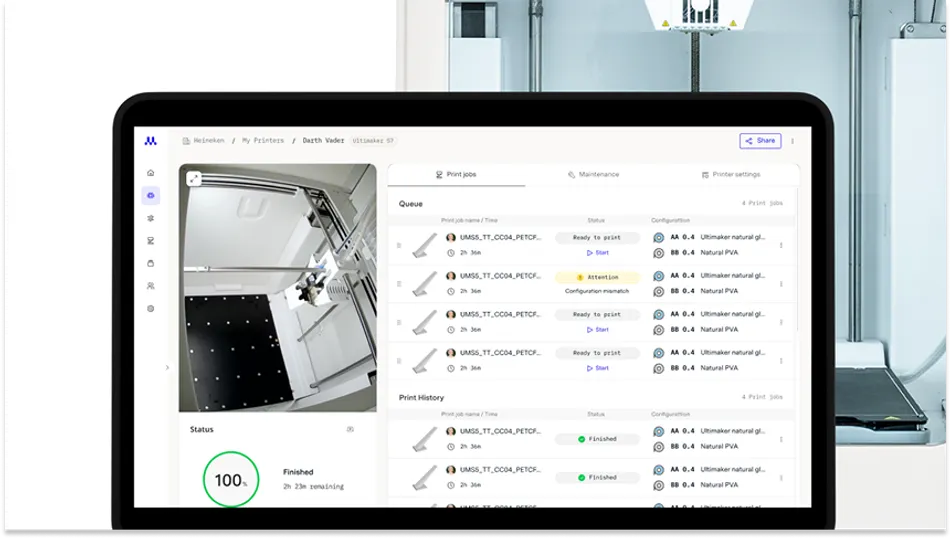
Ecosystem of additive manufacturing
Additive manufacturing technology requires an entire ecosystem around it to function efficiently. Below are the four components of the ecosystem.
CAD and slicing softwareSoftware forms an integral part of the 3D printing ecosystem. Multiple software are required to complete the 3D printing process. These include CAD design softwares like Catia, Creo, Fusion 360, and Solidworks to create the 3D model.
Slicing software takes the design file and prepares it for the printer. New cloud-based options such as Ultimaker Digital Factory add features like remote printing and monitoring, team collaboration and print queuing, and reporting for management.
MaterialFor additive manufacturing to make sense for your applications, material choice is crucial. Different AM technologies offer different ranges of materials. Some very specific and some more broad. The materials can be polymers, metals, composites, etc. (more on this in the Materials section of this article).
3D printer and supporting accessoriesThis is where the actual 3D printing process takes shape. Here, the design and associated settings combine to create the three-dimensional object. The final file is sliced and the print is started. In addition to the printer itself, other hardware accessories may come into play.
Post-processingAlmost every 3D printed object requires some level of post-processing and so this also forms an essential part of the 3D printing ecosystem. Post-processing techniques range from basic support removal, sanding, and painting to more complex processes like debinding and sintering for FDM metal prints which results in a solid metal part. Different technologies have different requirements as well. Powder-based systems require the removal of the print from a bed of powder, while resin-based systems require washing harmful resins and post-curing.
Materials used in additive manufacturing
The range of materials compatible with additive manufacturing technologies has expanded dramatically since the early days of rapid prototyping, enabling a wide array of industrial applications. This diversity of materials is a key factor in AM's growing adoption across various sectors. Let's explore the diverse materials used in AM:
Polymers
Polymers were the very first materials to be developed for 3D printing. FDM 3D Printers use filament on spools like those manufactured by Ultimaker. Ultimaker manufactures and sells high-quality polymers like ABS, Nylon, PET Carbon Fiber, PLA, ASA, PETG, PVA and more.
Polymers are also used as resins in Vat Photopolymerization type of 3D printers and as powders in powder-bed fusion type of 3D printers.
They remain the most widely used materials in additive manufacturing, offering versatility and cost-effectiveness.
Recent developments have introduced high-performance polymers with enhanced mechanical properties, temperature resistance, and chemical compatibility, expanding the use of AM in aerospace and automotive industries.
Metals
Metal AM has seen significant growth, particularly in industries requiring complex, high-value parts:
- Titanium alloys: Prized in aerospace and medical applications for their strength-to-weight ratio
- Aluminum alloys: Used for lightweight parts in automotive and aerospace
- Stainless steels: Offering corrosion resistance for various industrial applications
- Superalloys: Such as Inconel, used in high-temperature environments
- Precious metals: Including gold and silver for jewelry and dental applications
Advancements in metal AM have focused on improving material properties, reducing porosity, and developing new alloys specifically optimized for additive processes.
Ceramics
Ceramic is a popular material generally associated with pottery or kitchen items. But it is also widely used in industries because of its ultra-high heat tolerance. As a result, companies have developed ceramic materials for 3D printing in FDM, SLA, and Binder Jetting technologies.
While less common than polymers and metals, ceramic AM is gaining traction in specialized applications:
- Oxide ceramics: Such as alumina and zirconia, used in dental and medical implants
- Technical ceramics: Offering high temperature and wear resistance for industrial components
Ceramic AM processes are evolving to address challenges like shrinkage and porosity, opening up new possibilities in industries requiring high-performance ceramic parts.
Composites
Composite materials in AM combine the properties of different materials to achieve enhanced performance:
- Fiber-reinforced polymers: Incorporating carbon or glass fibers for increased strength and stiffness
- Metal matrix composites: Combining metals with ceramic reinforcements for improved wear resistance
- Functionally graded materials: Varying material composition throughout a part to optimize properties
The ability to precisely control material placement in AM allows for the creation of composite structures not possible with traditional manufacturing methods.
Biomaterials
The medical and bioengineering fields are driving innovation in biocompatible and biodegradable materials for AM:
- Biocompatible polymers: Such as PCL and PLA, used in tissue engineering scaffolds
- Hydrogels: Soft, water-containing networks used in bioprinting applications
- Bioceramics: Including hydroxyapatite for bone tissue engineering
These materials are enabling the production of patient-specific implants, drug delivery systems, and even living tissue constructs.
ConcreteConcrete is one of the newest materials to be introduced in 3D printing to cater to the construction application. The use of this material is quite limited right now but shows huge potential in the coming future.
Novel and Emerging Materials
The field of AM materials is constantly evolving, with researchers exploring new possibilities:
- Metamaterials: Engineered structures with properties not found in nature
- Smart materials: Capable of changing properties in response to external stimuli
- Nanomaterials: Incorporating nanoparticles to enhance specific properties
These cutting-edge materials are pushing the boundaries of what's possible with additive manufacturing, opening up new applications and industries.
Material Development Challenges
Despite the wide range of materials available, several challenges remain in AM material development:
- Ensuring consistent material properties across different AM processes and machines
- Developing materials that can match or exceed the performance of traditionally manufactured parts
- Creating multi-material systems that can be processed simultaneously
- Improving the sustainability and recyclability of AM materials
Addressing these challenges is crucial for the continued growth and adoption of additive manufacturing across industries.
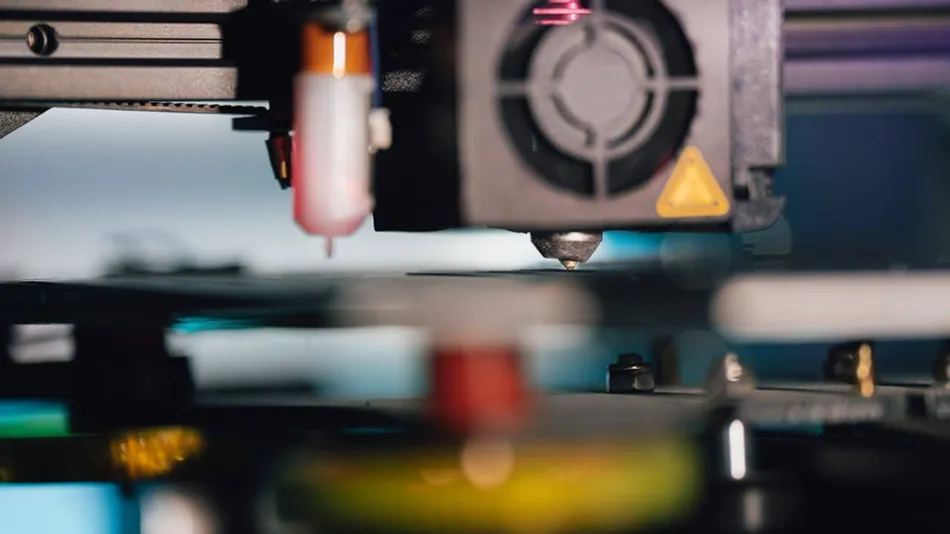
Additive manufacturing in action: real-world examples and applications
Additive manufacturing has found applications across a wide range of industries, showcasing its transformative potential. By examining real-world examples, we can see how the unique capabilities of AM - from design freedom to material innovation - are being leveraged to solve complex problems and create new opportunities. Let's explore some key applications:
Aerospace: Pushing the boundaries of performance
The aerospace industry has been an early adopter and key driver of AM innovation:
- GE Aviation's LEAP engine fuel nozzle: This complex component, previously assembled from 20 parts, is now 3D printed as a single unit. The redesigned nozzle is 25% lighter and five times more durable than its predecessor.
- Airbus' bionic partition: Using generative design and AM, Airbus created a cabin partition that is 45% lighter than traditional designs while maintaining strength, potentially saving airlines millions in fuel costs.
These examples demonstrate how AM enables part consolidation and weight reduction, critical factors in aerospace applications.
Automotive: Customization and efficiency
Automotive manufacturers are leveraging AM for both prototyping and production:
- BMW's individualization options: Using AM, BMW offers customers the ability to customize interior trim pieces, showcasing the technology's potential for mass customization.
- Bugatti's 3D printed brake caliper: Made from titanium, this AM-produced component is 40% lighter than its traditionally manufactured aluminum counterpart while offering superior strength.
These applications highlight AM's ability to produce complex, lightweight parts and enable personalization at scale.
Healthcare: Personalized medicine and devices
The medical field has embraced AM for its ability to create patient-specific solutions:
- Customized prosthetics: Companies use 3D scanning and printing to create affordable, highly personalized prosthetic limbs.
- Patient-specific implants: Surgeons are using AM to produce titanium implants tailored to individual patient anatomy, improving outcomes in complex reconstructive surgeries.
- Bioprinting: Researchers are making strides in printing living tissues, with potential applications in drug testing and eventually organ transplantation.
These examples showcase how AM is revolutionizing patient care through personalization and biomimicry.
Consumer goods: Rapid prototyping and mass customization
Consumer product companies are using AM to accelerate product development and offer unique customer experiences:
- Adidas' Futurecraft 4D shoes: Using Digital Light Synthesis technology, Adidas produces midsoles with complex lattice structures, tailored for performance and comfort.
- Gillette's Razor Maker: This platform allowed customers to design and order personalized razor handles, demonstrating AM's potential for mass customization in consumer products.
These applications illustrate how AM is bridging the gap between mass production and personalization in consumer goods.
Architecture and construction: Large-scale printing
The construction industry is exploring AM for its potential to revolutionize building processes:
- 3D printed homes: Companies are using large-scale AM to rapidly construct affordable housing, potentially addressing global housing shortages.
- 3D printed bridge: A fully functional stainless steel pedestrian bridge in Amsterdam showcases the potential for AM in infrastructure projects.
These examples demonstrate how AM is scaling up to address challenges in construction and urban development.
Industrial manufacturing: Tooling and spare parts
Beyond end-use parts, AM is transforming manufacturing processes themselves:
- Jigs and fixtures: Companies are using AM to produce custom tooling, reducing lead times and costs in their production lines.
- Digital inventories: Some companies have implemented digital spare parts inventories, allowing on-demand production of replacement parts and reducing physical inventory costs.
Check out this white paper on industrial manufacturing and transform your processes!
These applications showcase how AM is streamlining manufacturing operations and supply chains.
Emerging applications: Pushing the boundaries
As AM technologies continue to advance, new and innovative applications are emerging:
- 4D printing: Researchers are developing materials that can change shape or properties over time, with potential applications in adaptive structures and self-assembling products.
- Food printing: Companies are exploring AM for creating customized food items, potentially addressing nutritional needs or creating unique culinary experiences.
- Space exploration: NASA is investigating AM for in-situ resource utilization on Mars, potentially enabling astronauts to 3D print tools and structures using local materials.
These cutting-edge applications hint at the future potential of AM to transform even more industries and aspects of our lives.
Advantages and limitations of additive manufacturing
Additive manufacturing offers significant advantages over traditional manufacturing methods, but it also has limitations. Understanding these pros and cons is crucial for effectively leveraging AM in industrial applications. Let's examine the key benefits and challenges of AM:
Advantages of additive manufacturing
1. Design freedom and complexity
AM enables the creation of complex geometries that would be difficult or impossible to produce using traditional methods. This includes:
- Internal channels and lattice structures for improved performance
- Topology-optimized designs for maximum strength-to-weight ratios
- Consolidation of multiple parts into single, more efficient components
2. Customization and personalization
The ability to easily modify designs without tooling changes allows for:
- Mass customization, as seen in personalized consumer products
- Patient-specific medical devices and implants
- Tailored solutions for niche markets or individual customers
3. Rapid prototyping and iteration
AM significantly accelerates the product development cycle by:
- Reducing the time and cost of producing prototypes
- Enabling quick design iterations and testing
- Facilitating faster market feedback and product optimization
4. On-demand production and reduced inventory
AM allows for:
- Just-in-time manufacturing of parts
- Reduced warehousing costs and inventory risks
- Localized production, potentially closer to the point of use
5. Material efficiency and sustainability
AM can contribute to more sustainable manufacturing practices through:
- Reduced material waste compared to subtractive methods
- Lightweight designs that reduce material use and energy consumption in end products
- Potential for using recycled or bio-based materials in certain AM processes
Limitations and challenges of additive manufacturing
1. Production speed and volume
Despite recent advancements, AM generally remains slower for high-volume production compared to traditional methods like injection molding. This limits its applicability for mass production of simple, standardized parts.
2. Material constraints
While the range of AM-compatible materials has expanded significantly, some limitations persist:
- Not all traditional manufacturing materials are suitable for AM processes
- AM materials can be more expensive than their traditional counterparts
- Ensuring consistent material properties across different AM machines and processes remains a challenge
3. Size limitations
Most AM systems have build volume constraints, limiting the size of parts that can be produced in a single print. While large-scale AM is emerging in construction, it's still not widely available across all industries.
4. Surface finish and precision
Depending on the AM process used, parts may require post-processing to achieve desired surface finishes or meet tight tolerances. This can add time and cost to the overall production process.
5. Regulatory and quality control challenges
As AM adoption increases in regulated industries like aerospace and healthcare, ensuring consistent quality and developing appropriate standards and certification processes remains an ongoing challenge.
6. Cost considerations
While AM can be cost-effective for low-volume or complex parts, the initial investment in equipment and materials can be high. Additionally, the per-unit cost for high-volume production often remains higher than traditional methods.
Balancing advantages and limitations
Understanding these advantages and limitations is crucial for effectively leveraging AM in industrial applications. The key is to identify where AM's unique capabilities align with specific manufacturing needs:
- Complex, low-volume parts may be ideal candidates for AM
- Hybrid approaches combining AM with traditional methods can maximize benefits
- Continuous advancements in AM technologies are gradually addressing current limitations
As additive manufacturing continues to evolve, ongoing research and development efforts are focused on overcoming these limitations, potentially expanding the technology's applicability across more industries and applications.
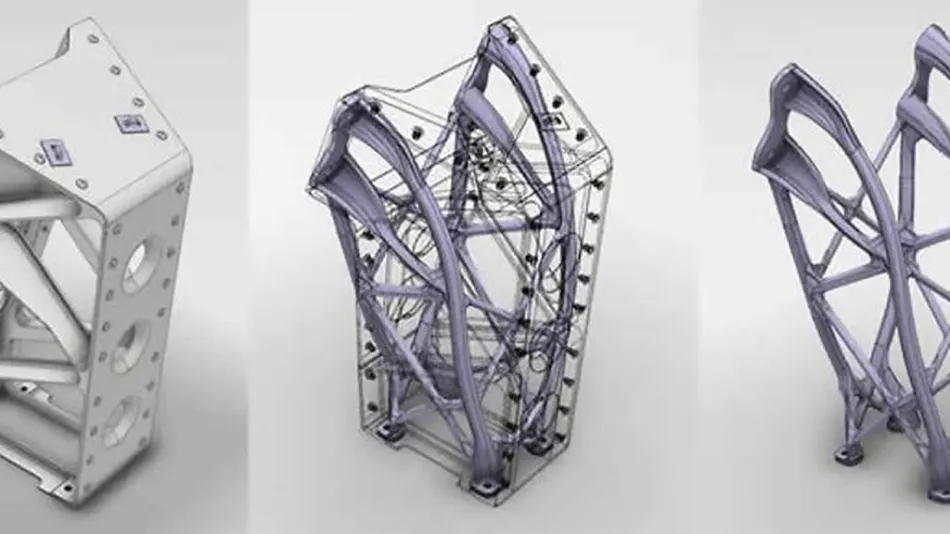
The role of additive manufacturing in engineering and product development
Additive manufacturing is reshaping engineering practices and enabling new approaches to product creation. Its impact extends throughout the entire product development lifecycle, from initial concept to final production. Let's examine how AM is transforming various aspects of engineering and product development:
Transforming the design process
Design for additive manufacturing (DfAM)
DfAM encourages engineers to leverage AM's unique capabilities:
- Exploring complex geometries that optimize performance
- Integrating multiple functions into single parts
- Utilizing generative design and topology optimization tools
Rapid iteration and testing
AM enables engineers to:
- Quickly produce and test multiple design iterations
- Conduct physical testing earlier in the development process
- Gather user feedback on functional prototypes before committing to tooling
Enhancing collaboration and communication
AM is fostering better collaboration across engineering teams and with stakeholders:
- Physical models improve communication of design intent
- Cross-functional teams can rapidly prototype and refine ideas together
- Customers and end-users can interact with prototypes earlier in the development process
Enabling New Product Development Strategies
Agile Hardware Development
Some companies are adopting agile approaches to hardware development, enabled by AM's rapid prototyping capabilities.
Continuous Product Improvement
The ability to easily modify designs allows for:
- Ongoing product refinement based on user feedback
- Faster response to market changes or new requirements
- Customized product variants for different market segments
Integrating AM into engineering workflows
Digital thread and model-based definition
AM is driving the adoption of fully digital workflows, where a single 3D model serves as the authoritative source for design, analysis, and manufacturing.
Simulation and virtual testing
Advanced simulation tools are being developed to:
- Predict AM part performance and optimize print parameters
- Simulate the printing process to identify potential issues
- Reduce the need for physical prototypes in some cases
Addressing engineering challenges
Engineers must navigate AM's limitations:
- Material properties and certification: Ensuring consistent material properties and developing certification processes for AM parts remains a challenge, particularly in regulated industries.
- Design tool evolution: CAD software is evolving to better support AM-specific features like lattice structures and multi-material designs, but there's still room for improvement.
- Post-processing considerations: Engineers must account for post-processing requirements in their designs, balancing the freedom of complex geometries with practical manufacturing considerations.
Future directions
Several trends are shaping the future of AM in engineering and product development:
- AI-driven design: Machine learning algorithms are being developed to generate optimized designs for AM, potentially automating aspects of the design process.
- Digital twins: The integration of AM with IoT and data analytics is enabling the creation of digital twins, allowing for predictive maintenance and performance optimization.
- Sustainable design: AM's material efficiency is driving new approaches to sustainable product design, including considerations for recyclability and end-of-life disassembly.
As additive manufacturing continues to mature, its integration into engineering and product development processes will likely deepen, enabling more innovative, efficient, and responsive approaches to creating the products of tomorrow.
The future of additive manufacturing: Trends and innovations
The field of additive manufacturing continues to advance rapidly, with new innovations and trends emerging that promise to further revolutionize manufacturing and product development. Let's examine some of the most exciting developments on the horizon for AM:
Multi-material and multi-functional printing
Researchers and companies are pushing the boundaries of what's possible with multi-material printing:
- Gradient materials: Creating parts with seamless transitions between different materials or properties
- Embedded electronics: Integrating conductive materials and electronic components directly into 3D printed structures
- 4D printing: Developing materials that can change shape or properties over time in response to external stimuli
These advancements will enable the creation of more complex, integrated products with enhanced functionality and performance.
Artificial intelligence and machine learning integration
AI and machine learning are set to play a crucial role in the future of AM:
- Generative design optimization: AI algorithms that can create highly optimized, organic designs tailored for AM
- Process parameter optimization: Machine learning models that automatically adjust printing parameters for optimal quality and efficiency
- Predictive maintenance: AI-driven systems that can anticipate and prevent machine failures, reducing downtime
These AI-powered tools will not only improve the quality and efficiency of AM processes but also expand the creative possibilities for designers and engineers.
In-Situ monitoring and closed-loop control
Advanced monitoring systems are being developed to ensure consistent part quality:
- Real-time defect detection: Using sensors and machine vision to identify and correct issues during the printing process
- Closed-loop feedback: Systems that can automatically adjust printing parameters based on real-time monitoring data
- Digital twins: Creating virtual representations of printed parts that evolve alongside the physical object, enabling predictive analysis and optimization
These advancements will be crucial for expanding AM adoption in highly regulated industries like aerospace and medical devices.
Large-scale and high-speed printing
Efforts to overcome the size and speed limitations of current AM systems are yielding promising results:
- Continuous liquid interface production (CLIP): Technologies that enable faster printing speeds by eliminating the layer-by-layer approach
- Robotic and mobile printing systems: Large-scale AM solutions for construction and infrastructure applications
- Hybrid manufacturing: Combining AM with traditional manufacturing processes for increased speed and flexibility
These developments will expand the range of applications for AM, particularly in industries requiring large parts or high-volume production.
Sustainable and circular manufacturing
As sustainability becomes increasingly important across industries, AM is poised to play a key role in more environmentally friendly manufacturing practices:
- Recycled and bio-based materials: Development of new AM-compatible materials from recycled or renewable sources
- Localized production: Distributed manufacturing networks that reduce transportation emissions and enable on-demand production
- Design for disassembly: Creating products that are easier to recycle or remanufacture at end-of-life
These trends align with the growing focus on circular economy principles and will likely drive further adoption of AM technologies.
Standardization and certification
Significant efforts are underway to develop standards and certification processes for AM:
- Material and process standardization: Establishing industry-wide standards for AM materials and processes to ensure consistency and quality
- Non-destructive testing methods: Developing new techniques for verifying the quality and integrity of AM parts without damaging them
- Qualification and certification frameworks: Creating standardized approaches for qualifying AM processes and certifying parts for critical applications
These efforts will be crucial for expanding AM adoption in highly regulated industries and ensuring the reliability of AM-produced parts.
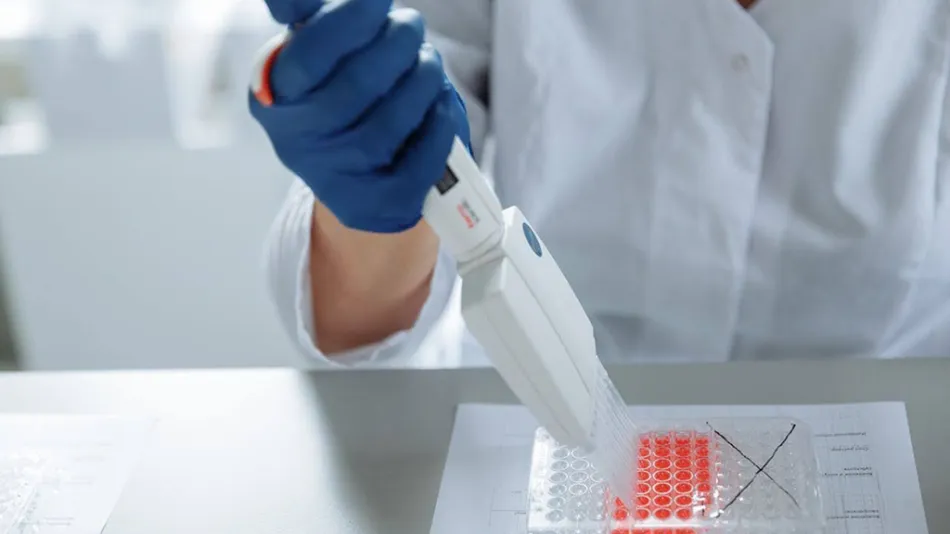
Bioprinting and medical applications
Bioprinting is an area of intense research and development:
- Tissue engineering: Creating complex, living tissue structures for transplantation or drug testing
- Personalized medicine: 3D printing of custom drug delivery systems or patient-specific implants
- In-situ bioprinting: Development of portable bioprinting systems for direct application of tissue or skin grafts
These advancements have the potential to revolutionize healthcare and personalized medicine.
Conclusion: A transformative future
As we look to the future of additive manufacturing, it's clear that the technology is poised for continued growth and innovation. The trends and developments discussed here build upon the foundations we've explored throughout this guide, addressing current limitations while unlocking new possibilities.
From AI-driven design to sustainable materials and bioprinting, the future of AM promises to further blur the lines between the digital and physical worlds, enabling unprecedented levels of customization, efficiency, and innovation across industries. As these technologies mature and become more widely adopted, we can expect to see additive manufacturing play an increasingly central role in shaping the products and manufacturing processes of tomorrow.
By staying informed about these emerging trends and continuing to explore the potential of AM, businesses and professionals can position themselves at the forefront of this manufacturing revolution, ready to leverage its transformative power in their respective fields.
Become an industry leader with UltiMaker
3D printing is not merely a complementary technology, it is reshaping the manufacturing landscape. At the cutting edge, UltiMaker 3D printers empower companies to innovate rapidly, cut costs, and create complex designs and paves the way for a more agile and efficient future.
